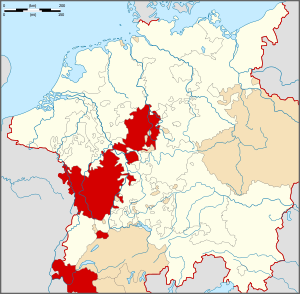Prince-Bishopric of Strasbourg
The Prince-Bishopric of Strassburg (German: Fürstbistum Straßburg; Alsatian: Fìrschtbischofsìtz Strossburi(g)) was an ecclesiastical principality of the Holy Roman Empire from the 13th century until 1803. During the late 17th century, most of its territory was annexed by France; this consisted of the areas on the left bank of the Rhine, around the towns of Saverne, Molsheim, Benfeld, Dachstein, Dambach, Dossenheim-Kochersberg, Erstein, Kästenbolz, Rhinau, and the Mundat (consisting of Rouffach, Soultz, and Eguisheim). The annexations were recognized by the Holy Roman Empire in the Treaty of Ryswick of 1697. Only the part of the state that was to the east of the Rhine remained; it consisted of areas around the towns of Oberkirch, Ettenheim, and Oppenau. The remaining territory was secularized to Baden in 1803.
Prince-Bishopric of Strassburg Fìrschtbischofsìtz Strossburi(g) (als) Fürstbistum Straßburg (de) | |||||||||||
|---|---|---|---|---|---|---|---|---|---|---|---|
| 982–1803 | |||||||||||
.svg.png) Flag
 Coat of arms
| |||||||||||
 The Prince-Bishopric of Strassburg, circa 1547 | |||||||||||
| Status | Prince-Bishopric | ||||||||||
| Capital | Straßburg | ||||||||||
| Common languages | Alsatian | ||||||||||
| Government | Prince-Bishopric | ||||||||||
| Historical era | Middle Ages | ||||||||||
• Prince-Bishopric founded | before 343 | ||||||||||
• Gained autonomy | 775 982 | ||||||||||
| 982 | |||||||||||
1681 | |||||||||||
1697 | |||||||||||
| 1803 | |||||||||||
| |||||||||||
| Today part of | |||||||||||
| Part of the series on |
| Alsace |
|---|
Rot un Wiss, traditional flag of Alsace |
|
|
|
|
|
Alsace in the European Union |
|
Related topics |
See also
- Archbishop of Strasbourg
- Roman Catholic Archdiocese of Strasbourg
- Palais Rohan, Strasbourg
- Episcopal Palace (Strasbourg)
- Strasbourg Bishops' War
Notes
References
- Herbermann, Charles, ed. (1913). . Catholic Encyclopedia. New York: Robert Appleton Company.

.svg.png)

.svg.png)